 Social Sciences
Social Sciences
Fashion Sense
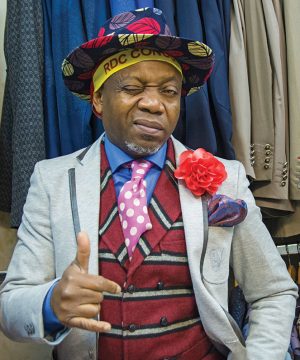
One of the rules of the society is the “trilogy of colors”—combining no more than three together. But Jocelyn Armel demonstrates in his multicolored ensemble, “Once a Sapeur knows the rules, he may start breaking them.”
“To die without having seen Paris is a sin.”
So says Jocelyn Armel (right, with boutonniére), whose life revolves around sartorial style. For this native of the Republic of the Congo, his first visit to the French fashion capital was nothing less than a sacred pilgrimage. He arrived in Paris as a teen and decided to stay, building a life for himself as a clothier.
It’s the perfect occupation for this member of la Sape (pronounced “sap”), a subculture in Africa and Europe that venerates cosmopolitan style, à la the dandies of the colonial era. The movement’s adherents, called Sapeurs, devote their lives—and often-meager incomes—to staying on the cutting edge of fashion. La Sape is an acronym for la Société des Ambianceurs et des Personnes Elégantes, which means “the society of ambiance makers and elegant people”; “sape” is also French slang for “attire.”
 Earlier this year, Hannah Steinkopf-Frank (left), who graduated from the Clark Honors College in June with degrees in international studies and journalism and a minor in African studies, interviewed Armel and other Sapeurs.
Earlier this year, Hannah Steinkopf-Frank (left), who graduated from the Clark Honors College in June with degrees in international studies and journalism and a minor in African studies, interviewed Armel and other Sapeurs.
For her thesis, Steinkopf-Frank examined la Sape, a society with roots dating to the 19th century and the French and Belgian colonists who arrived in the Congo wearing Western garments that the locals came to see as status symbols. In January, for her research, she spent three weeks in Paris and Brussels, interviewing and photographing more than a dozen Sapeurs who had left their homelands in search of a better life in the countries that colonized them. See a gallery of her photos below.
Whether they have found it depends on whom you ask. Sapeurs derive immense pride and satisfaction from stocking up on high-end designer labels—Christian Dior, Benetton, Marithé et François Girbaud—but many of them otherwise lead hardscrabble existences. Critics question the society’s priorities and note that some Sapeurs turn to petty crime to support their expensive habits.
The fashionistas’ stories illustrated to the student that a social movement is not a single entity but comprises individuals with their own experiences.
Said Steinkopf-Frank: “I realized, writing about la Sape, that it’s important to highlight the diversity of the community as well as what unifies it.”
—Matt Cooper
photos by Hannah Steinkopf-Frank
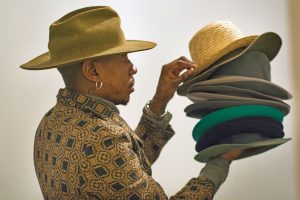
Sapeurs consider styling themselves in high fashion to be a transformative experience, describing their state as enchanted. “La Sape is a love,” said Robby Gianfranco of Paris. “It’s like a drug. It’s like someone who always thinks about drugs. I take two hours to get dressed.”
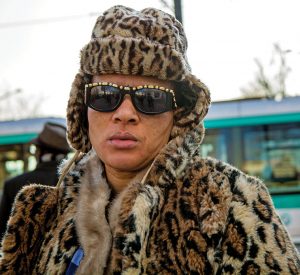
In Paris, the illusion of France as a land of bounty shatters for many Sapeurs, who are often undocumented, struggle to find work and constantly scramble to make ends meet. “The day you rest,” said Anto Meta, one of the minority of female Sapeurs, “will be the day you die.”
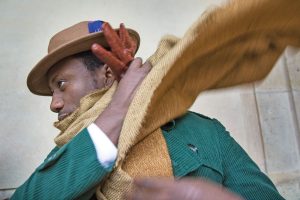
Maxime Kudimba, whose family is from the Democratic Republic of the Congo, is a member of Zamounda. The Paris-based fashion group is influenced by la Sape but distinguishes itself by eschewing a focus on designer brands. “The label is just a little thing,” he said. “You can put it on any clothing. It just shows the financial value, but it doesn’t make it elegant.”
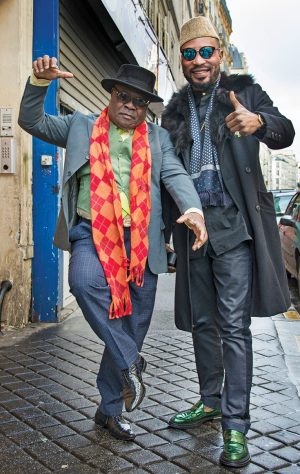
Ben Mouchacha (left) sports a classically colorful palette—a gray, pinstriped suit with a yellow shirt, green vest, a red and orange scarf and black hat. Kapangala Patoe (right) wears the modern, “relaxed” look—black pants, shirt and jacket, with metallic green loafers from John Galliano, mirrored Prada sunglasses and a Mobutu-esque toque.


 Twitter
Twitter Facebook
Facebook Forward
Forward